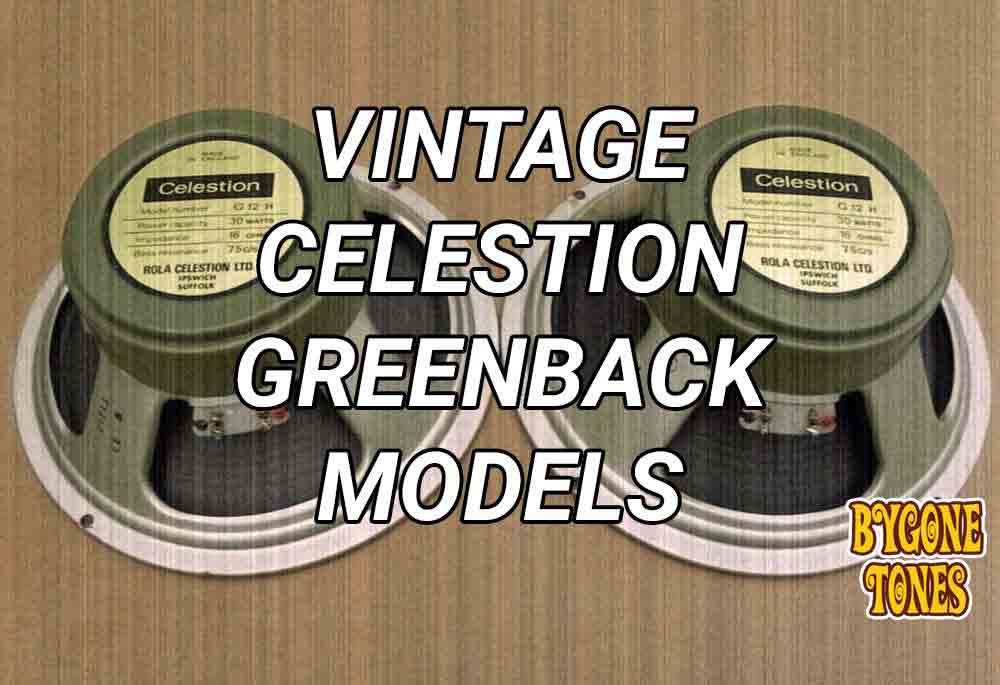
Quick links to the models mentioned on this page:
| G12H | G12M | G12S |
|---|---|---|
| T1134 | T1221 | T1417 |
| T1217 | T1220 | T1416 |
| T1234 | T1511 | T1440 |
| T1279 | T1871 | T1449 |
| T1281 | T1977 | T1517 |
| T1460 | T2114 | |
| T1534 | T2168 | |
| T1862 | ||
| T1886 | ||
| T1976 | ||
| T2115 |
Celestion Greenback Speakers – An Overview
Ceramic speakers (aka ‘greenbacks’) first appear around late 1964 to early 1965. They have a slightly more aggressive tone compared to the alnico magnet speakers. Amp manufacturers switched to ceramic speakers, mainly because they were cheaper than alnicos, but they also proved to be a perfect match for the edgy, over-driven guitar sound that was emerging at the time. Think Cream era Eric Clapton and Jimi Hendrix.
Magnet Sizes
The ceramic magnets used on Celestion greenback speakers came in four main sizes. The larger magnets have a higher power handling because they can absorb more heat.
- G12H – Heavy magnet (50oz) – rated 30w or 25w depending when made*
- G12M – Medium magnet (35oz) – 5 watts less power handling than G12H
- G12S – Small magnet (28oz) – 5 watts less power handling than G12M
- G12L – Light magnet (20oz) – 5 watts less power handling than G12S
Generally speaking, the bigger the magnet, the louder and bigger the sound will be. The G12H and G12M speakers are the most popular models.
*Power handling increased by 5 watts around late 1967 due to a change in the voice coil design.
Speaker Models
Shown below are some of the most commonly found greenback models from the 1960’s & 1970’s.
Note – the speakers evolved through the years, so any small details shown such as the cone stamps, labels, and magnet covers, may be different depending on when the speaker was made.
T1134 (15 Ohm)
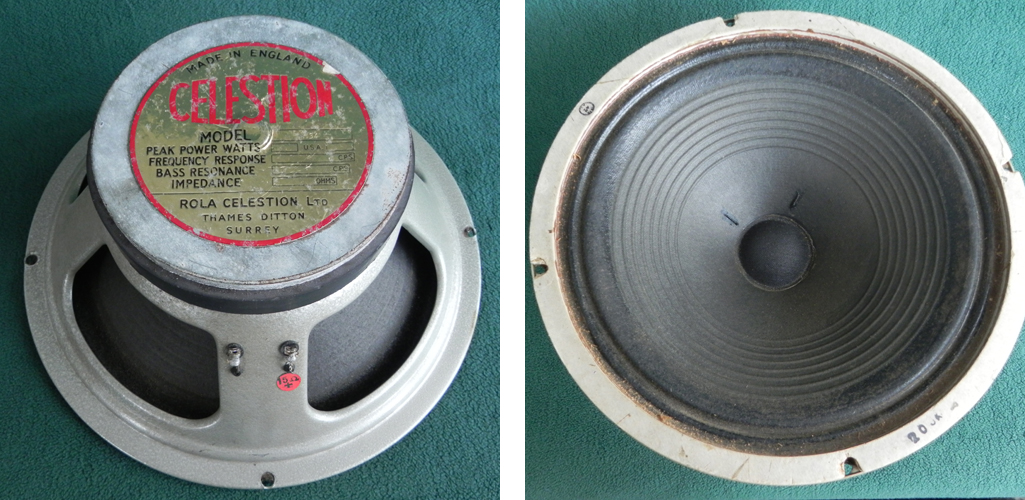
The T1134 model was probably the first ‘G12H’ speaker Celestion ever made.
According to the Celestion log book, it was first introduced in Nov 1964 and has an impedance of 10-12 Ohms. However, all the ones I have seen have been 15 Ohm.
They were mainly used by Selmer, probably as a successor to the T731 alnico. The T1217 quickly superseded the T1134, so they may have only had a production run of about 12 months or so. As such they are quite a rare speaker model.
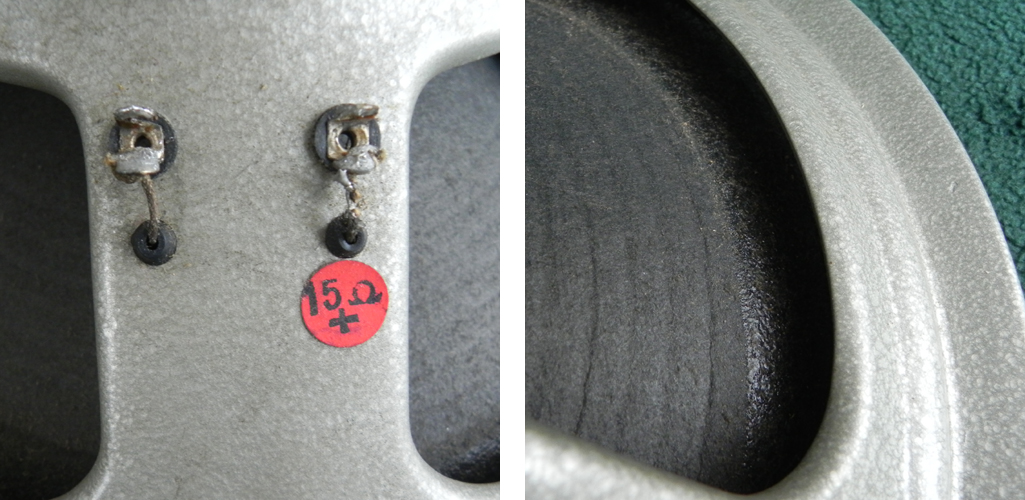
They usually have pulsonic cones stamped H1777 or 003 with the welvic doping on both sides of the cone. Rated 25 watt, with the hammered/oyster paint finish to the chassis.
Notice the unusual solder terminals. The lead wires come through a pair of rubber grommets below and then upto the metal solder points above, very few Celestion guitar speakers were made like this. The change in chassis design is probably the only noticable difference between T1217 and T1134. The log book entry for T1217 does confirm this: “as T1134 but with new type pressure housing”.
T1221 (15 Ohm) & T1220 (8 Ohm)
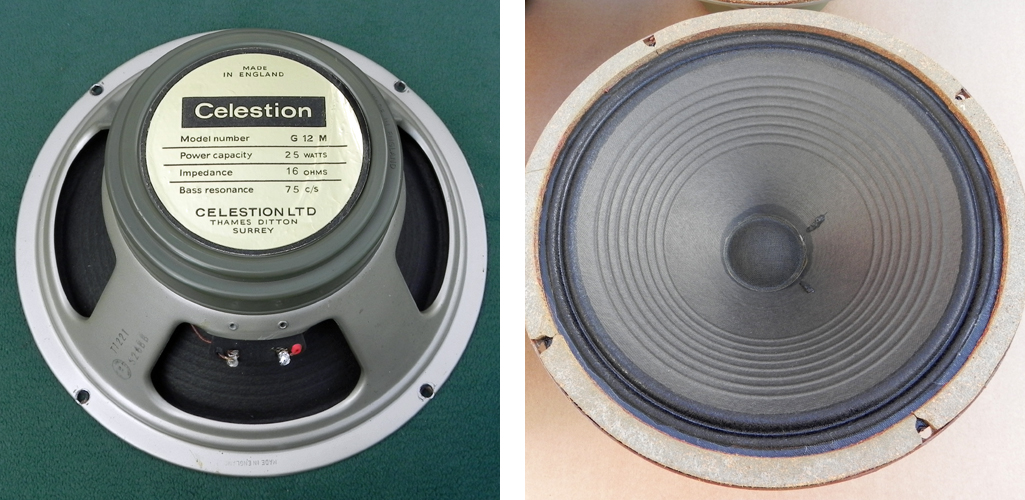
T1221 is Celestion’s most legendary speaker – the classic G12M speaker with the 75Hz cone. Known simply as “the greenback” ever since its reissue in the 80’s.
The T1221 was the stock speaker in Marshall lead guitar 4×12 cabinets (1960 model cabs) from the mid 1960’s up until the late 1970’s and was also used by many other brands at the time. As such it is an absolute classic speaker and can be heard on countless albums. Famously used by Angus Young and an important ingredient in Van Halen’s “brown sound”.
The date of entry into the Celestion log book is 6th May 1966 – see ‘Michael Doyle – History of Marshall’ – p137, however they were definitely made earlier than this. Marshall were using them in 4×12 cabs by late 1965, and I once owned one dated March 1965.
After a few years of non-production in the 1980’s – what were they thinking? – Celestion re-issued this speaker in the late 1980’s and they are still making them today, available as G12M Greenback.
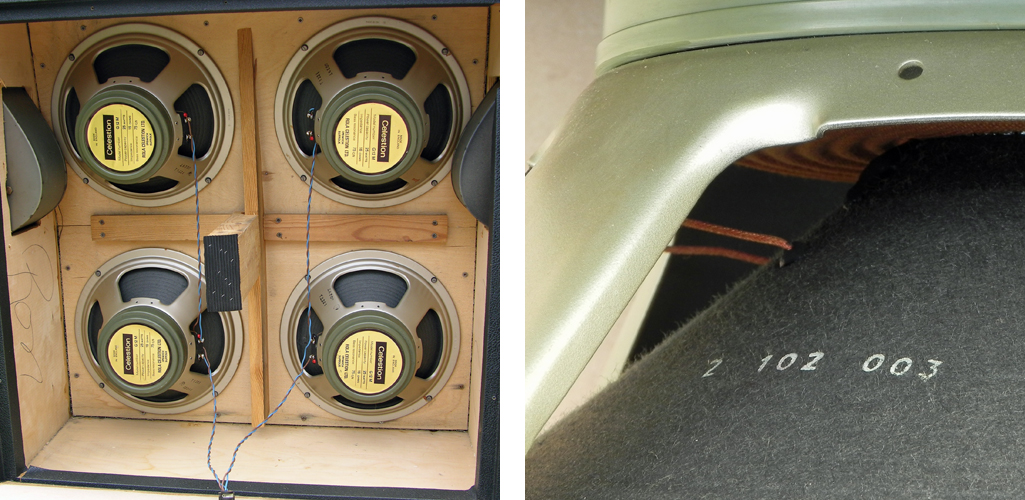
A popular speaker with classic rock and blues guitarists. People often describe the tone as ‘woody’. This is a tighter sounding speaker than the G12H and compresses nicely when pushed hard enough, with a warm and ‘juicy’ sounding mid-range, and a little more character to the tone than the G12H.
Other variants include the T2168, which is the same as the T1221 but without the plastic magnet cover.
Early Features:
The T1221 went through a lot of changes through the years. The original speakers had a power handling of 20w and had no doping at all on the cones, really great sounding speakers and it is very rare to find those first ones nowadays.
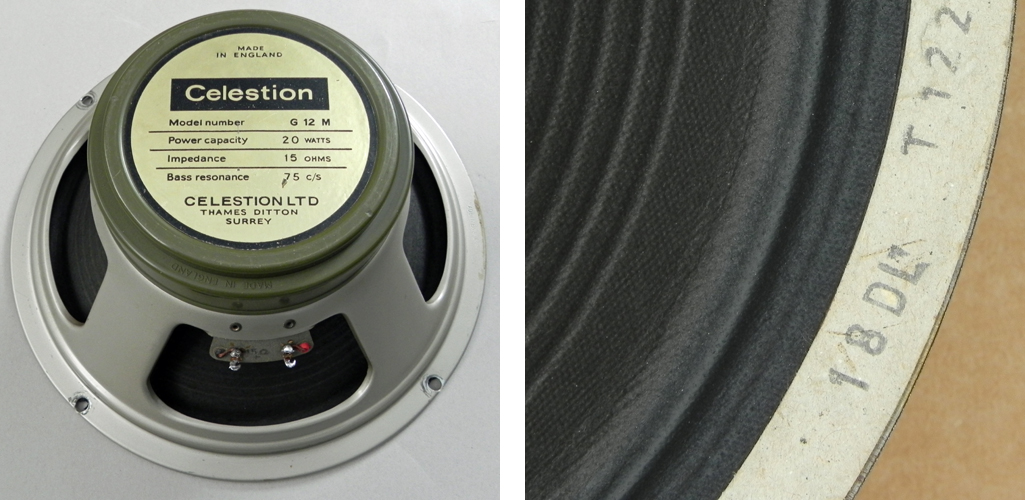
Over time Celestion made small changes to the specification, probably to make the speaker more durable. This included; more doping on the cone edge, and increased power handling. As a result the speaker had more warmth and loudness, but at the cost of other desirable traits such as responsiveness and clarity, in my opinion.
Unfortunately Celestion recently ceased production of their ‘Heritage’ greenback line. Their recreation of the late 1960’s pre-rola period speakers. Look out for them on the second hand market! However, at time of writing the EVH G12M is still in production, and is apparently the same speaker with a different label on it 😉 Grab them while you still can!
T1217 (15 Ohm) & T1234 (8 Ohm)
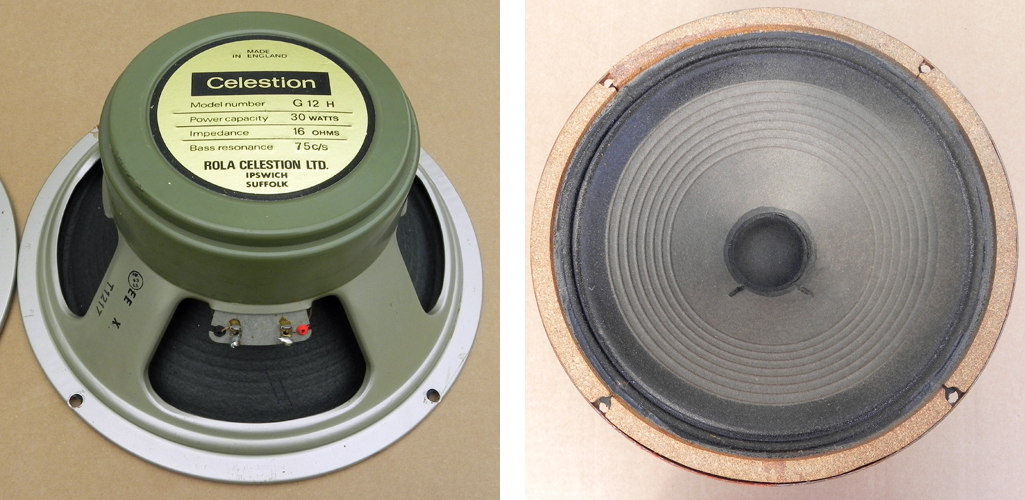
T1217 is easily the most common G12H Celestion greenback model from the 70’s. It was the stock speaker with many UK brands in the 1970’s, such as Orange and Carlsbro.
Very nice sounding speakers – louder than the G12M and more ‘boomy’, but less compressed and more fluid. Strong in the upper mid range.
To my knowledge the T1217 was never a stock speaker with Marshall. Watch out for the fake T1217’s with white Marshall labels on the back!
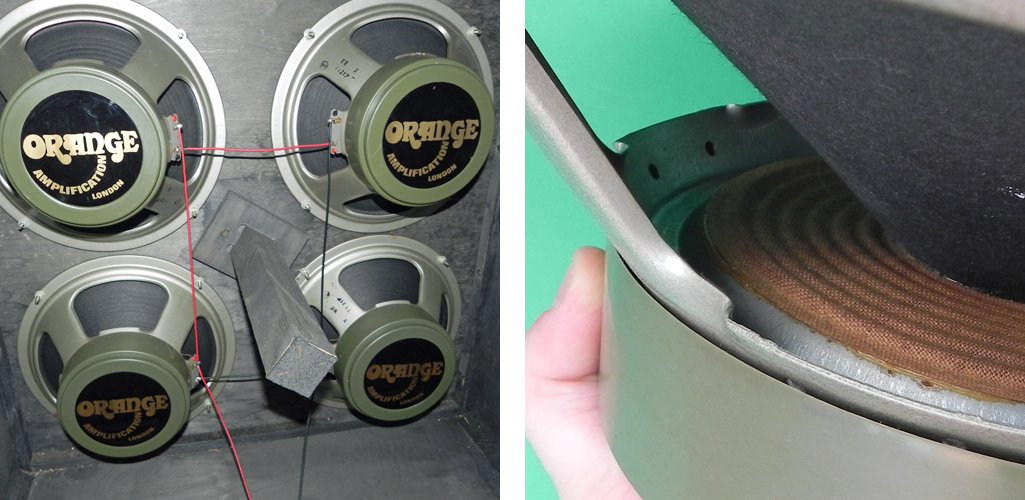
Similar speakers are the T1862; as T1234 but no plastic cover, and T1279; as T1234 but with the VOX/JMI colouration and label
Early features:
The date of entry into the Celestion log book shows 6th May 1966, however I have owned several examples earlier than this, and I have recently seen one example dating back to Dec 1965. Originally they looked very similar to the T1134 with just the gold Rola Thames Ditton labels on the back, but with the standard solder terminals. The familiar green covers appear very soon after this around March / April 66.
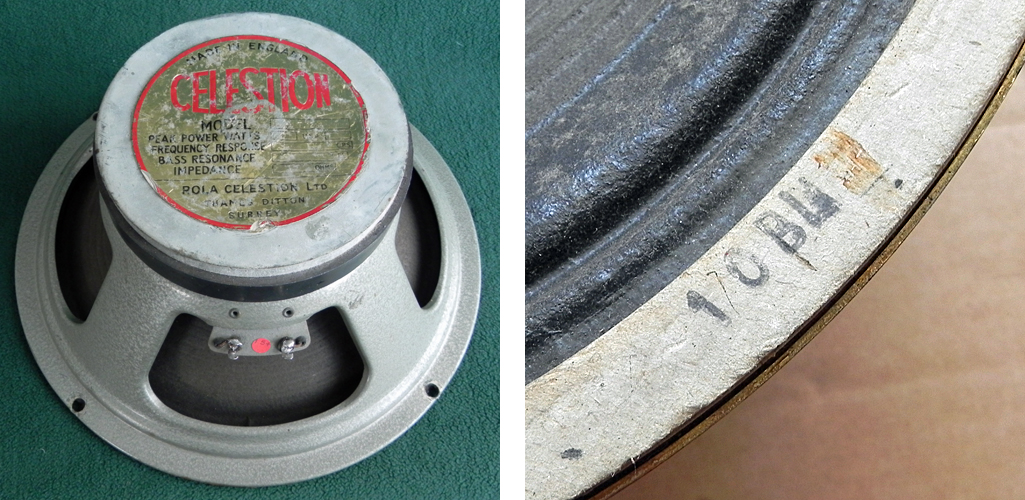
The first T1217’s had a power handling of 25 watts and had welvic doping on both sides of the cone. Around late 1967, the doping on the back of the cone was phased out, roughly the same time the voice coils were upgraded by 5 watts.
T1281 & T1534 (16 Ohm) & T1460 (8 Ohm)
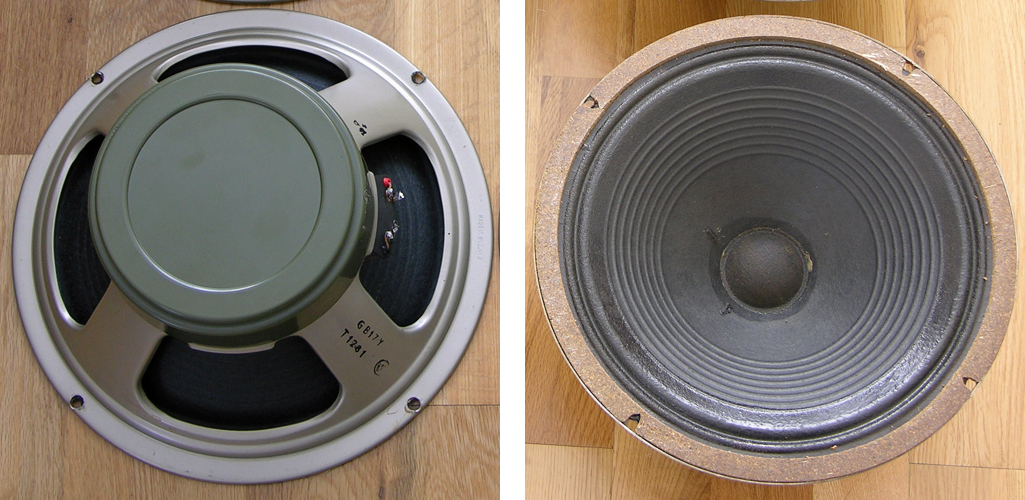
I am including T1281 and T1534 together here because they are basically the same speaker. According to ‘dr.decibel’ at Celestion.com, the T1281 is the Marshall labelled version, and T1534 is the standard Celestion label version. These are the G12H model with the 55Hz cones.
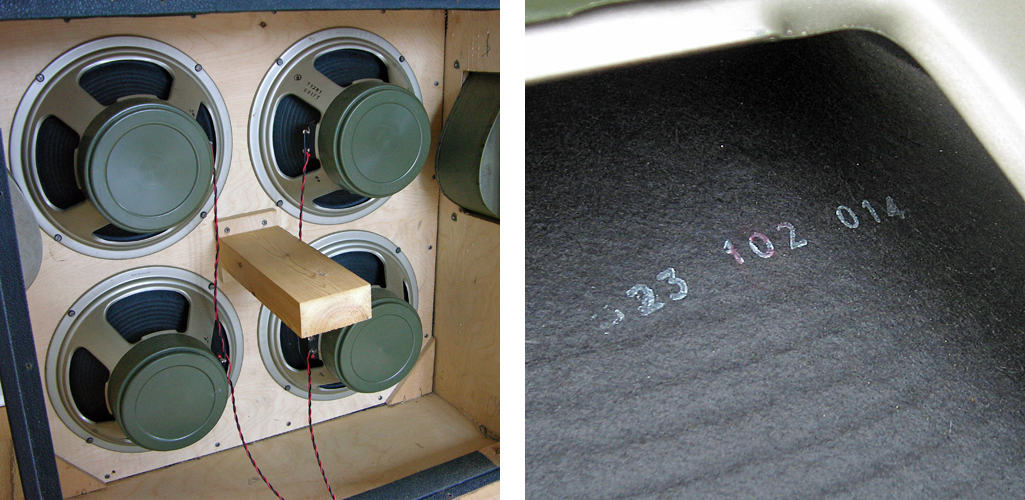
The T1281 first appears around September 1966 in the Marshall 4×12 cab models 1982 and 1976 (PA column) with the 100 logo in the top left corner. These 100w cabs were released in conjunction with the 200 watt Marshall Major amplifier.

T1281 is regarded by many as “the Hendrix speaker” because he can clearly be seen using these cabs in old footage.
Loud and bassy, with the thick sounding lower mids. Also used by countless other pioneering guitarists back in the 60’s such as Jimmy Page and Ritchie Blackmore. The T1281 is probably the most sought after greenback model of them all!
Early Features:
The original T1281 was a 25w speaker with the white voice coil fomer and the pulsonic cone usually stamped ‘SP444’. Like most G12H of the period it also came with the welvic doping on both sides of the cone.
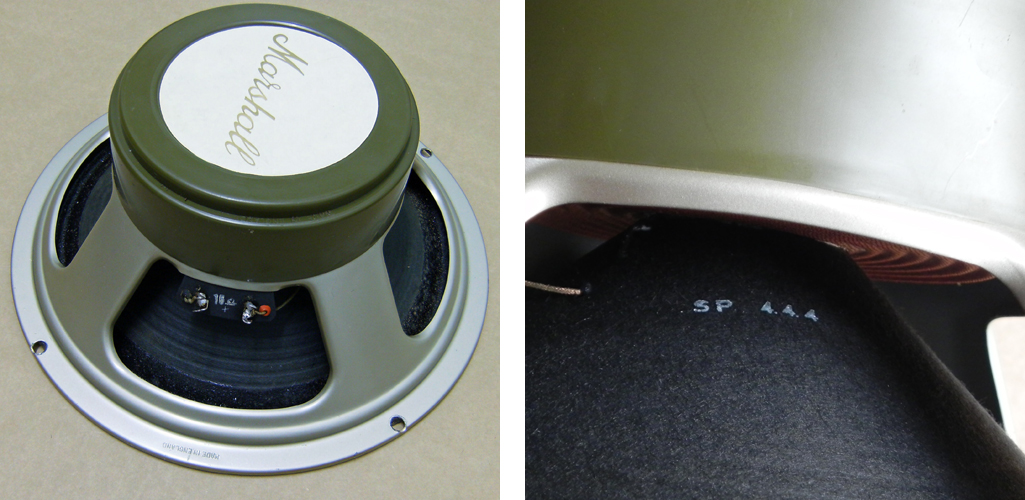
Quite a different sounding speaker to the more commonly seen 30w version made late 67 onwards. They are tighter sounding and less boomy. It is this 25w version that Jimi Hendrix was likely to be using in his iconic tall pinstripe Marshall stacks, most notably during his legendary Monterey performance in June 1967.

Very rare speakers to find in usable condition thesedays. Surprisingly, Celestion have never reissued this classic 25w G12H used by Hendrix. Come on guys!
T1511 (16 Ohm)
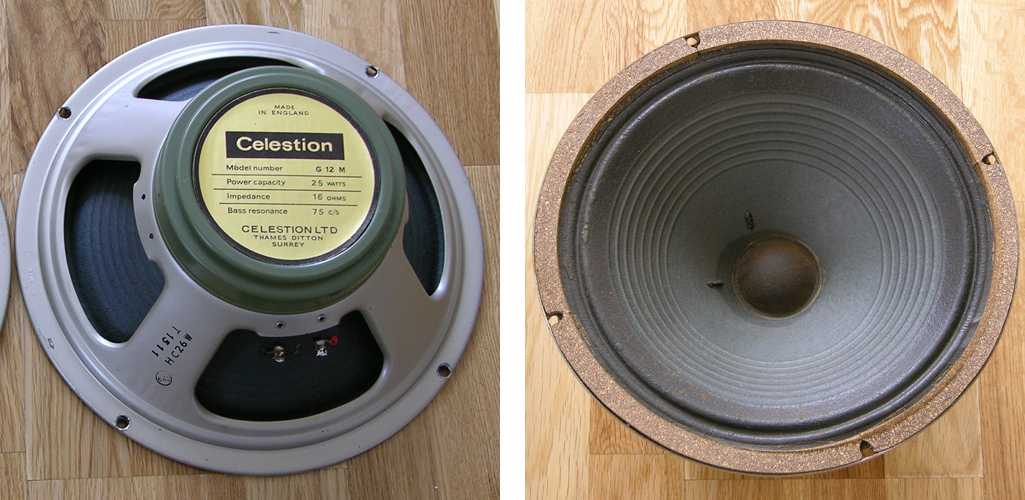
T1511 is the 55hz version of the G12M speaker. It was the stock speaker in Marshall bass cabs (model 1935) from around mid 1967 until the very late 1970’s. They were not exclusive to Marshall as I had originally thought, but are pretty rare to find in anything other than Marshall.
Notice the wide band of doping on the front edge of the cone compared with the T1221.
Pre-rola period speakers will always have 75hz printed on the labels. Look for the white ‘102 014’ stamp on the cone and this verifies that it is the 55Hz cone. Only the later ‘Rola Ipswich’ labels with the speaker symbol, circa 1972 onwards, tend to have 55hz printed on them.
Note – this has been my experience with ALL pre-rola 55hz speaker models, not just T1511. At that time Celestion did not have separate labels made for every speaker model they produced. No 55Hz label seems to have existed then. Celestion would share labels between models and alter the information with small stickers when necessary. See the labelling for model T1440 below as another example of this.
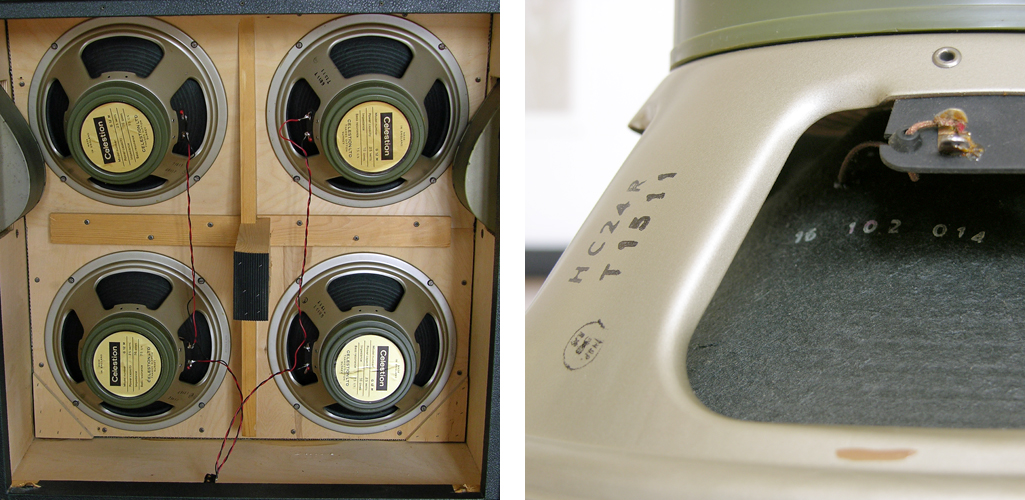
T1511 was designed for bass but is a popular speaker with guitar players due to the different tonal characteristics compared with the T1221. It has less mid-range, and more of a scooped tone.
This is another classic Celestion greenback model crying out to be reissued.
T1417 (16 Ohm) & T1416 (8 Ohm)
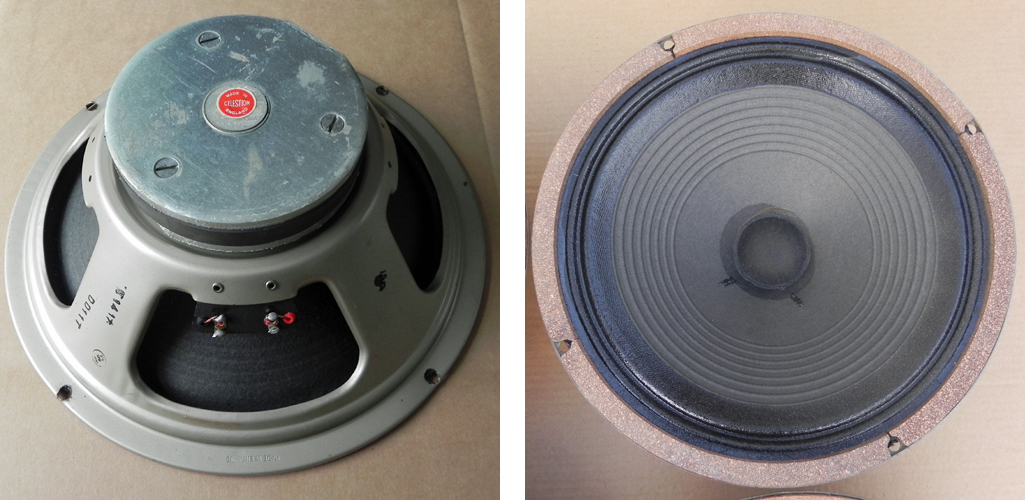
T1417 is the most commonly found ‘G12S’ model. It was used in various PA cabs and 1×12 combos in the 1970’s, and is apparently dr.decibel’s favourite speaker.
The G12S range are very mis-understood and under-valued speakers in my opinion. They are excellent speakers.
The T1417 is basically the same speaker as the T1221 G12M apart from the 7oz smaller magnet. It has a little less bass, and a little less volume, with a slightly warmer mid range. Ideal for playing at home or smaller venues.
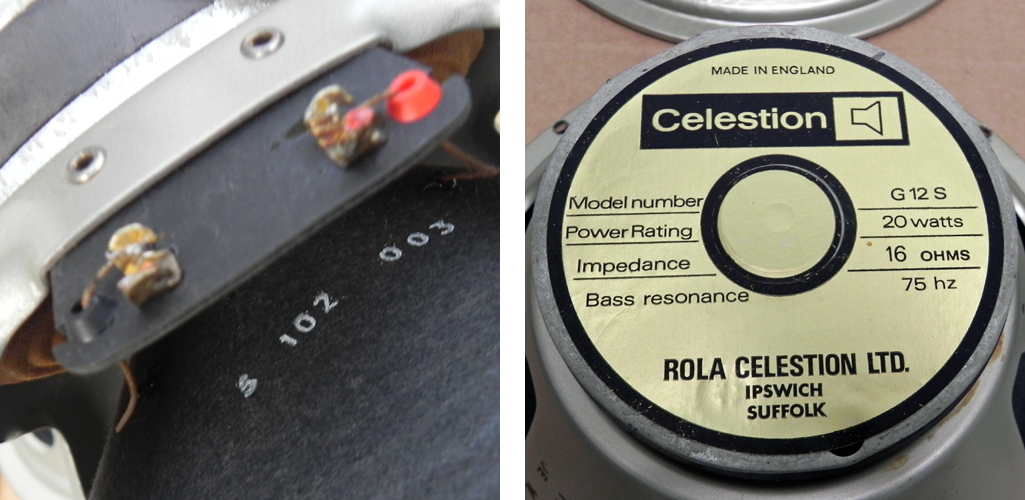
‘Pre-rola’ period speakers can be identified by the small red sticker in the center of the magnet (see first photo).
T1517 is a similar speaker often found in Selmer gear and usually has a G12M sized plastic magnet cover.
T1976 (16 Ohm)
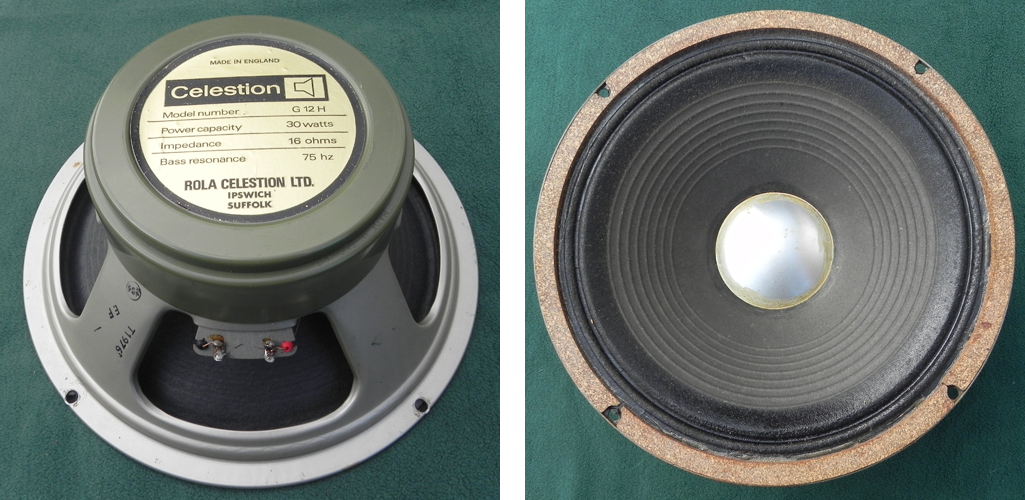
T1976 is a G12H greenback model often found in old Laney and Dan Armstrong gear. It has a 75Hz cone and silver dust cap.
Early examples (circa 71 to 73) with the pulsonic cones tend to have the four ridge spider support, and a solid dust cap.
Later speakers usually have the 6 ridge spider support, and a slightly different dustcap with a small black circular mesh in the center.

The four ridge spider is made from a softer material than the 6 ridge spider. It allows for more cone movement and this results in a louder speaker, with a looser feel.
T1977 (16 Ohm)
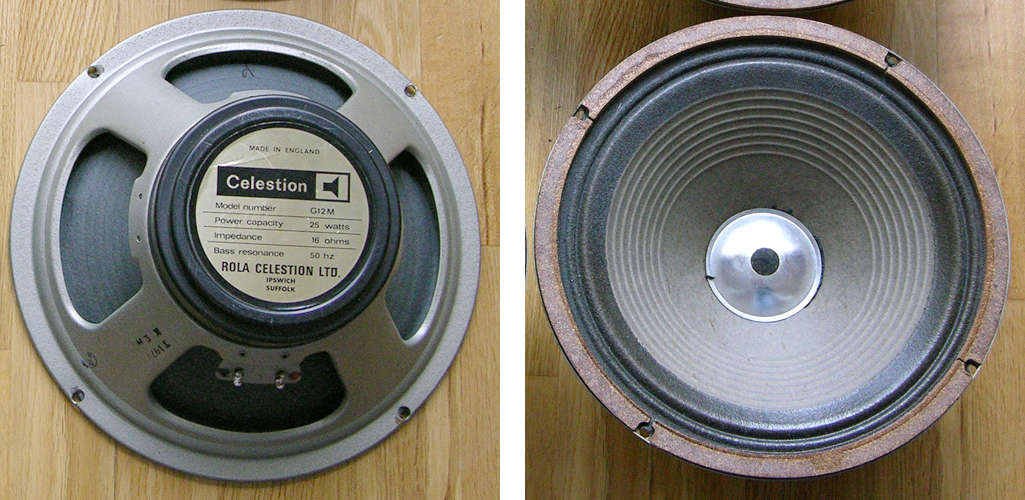
Quite a rare speaker model. G12M magnet with the 4 ridge spider support, low resonance 444 cone and silver cap. 50Hz bass resonance on the label.
T1886 (16 Ohm)
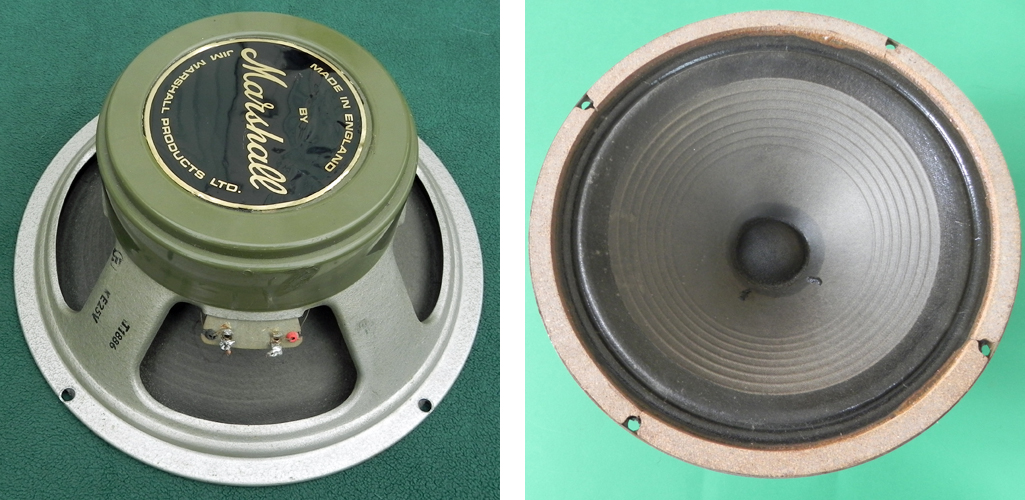
Quite a scarce G12H model with 55Hz cone and four ridge spider. Usually found in Marshall ‘Artiste’ combo amplifiers from the early 70’s. By the late 70’s they found their way into certain 4×12, and 2×12 Marshall cabs, usually Artiste or bass cabs.
T1886 sounds looser with more fluidity compared to the T1281, perhaps better suited to bass than guitar.
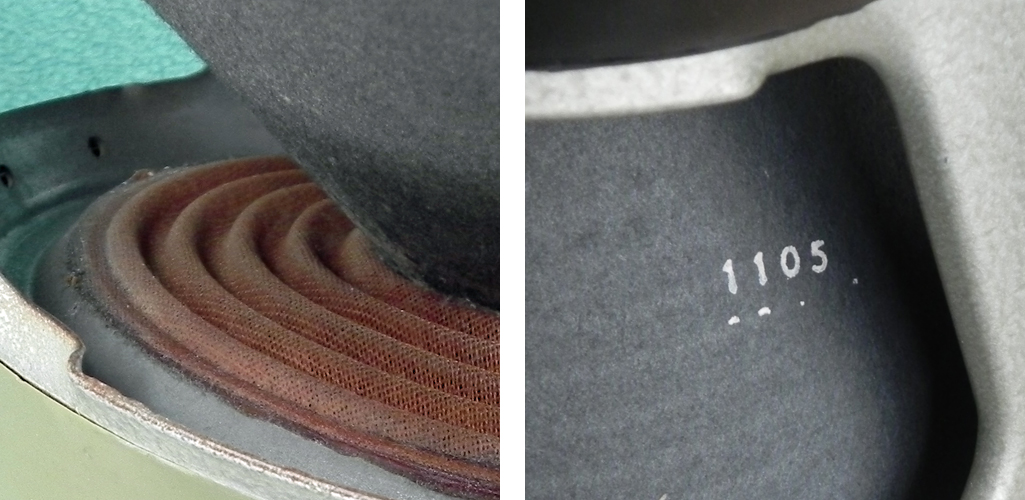
These have a different cone stamp to most other Celestion greenback models. Expect a ‘102/30’ stamp or just a single ‘5’ on pulsonic cone speakers, and ‘5011’ or ‘1105’ on blackback period speakers.
T1871 (8 Ohm)
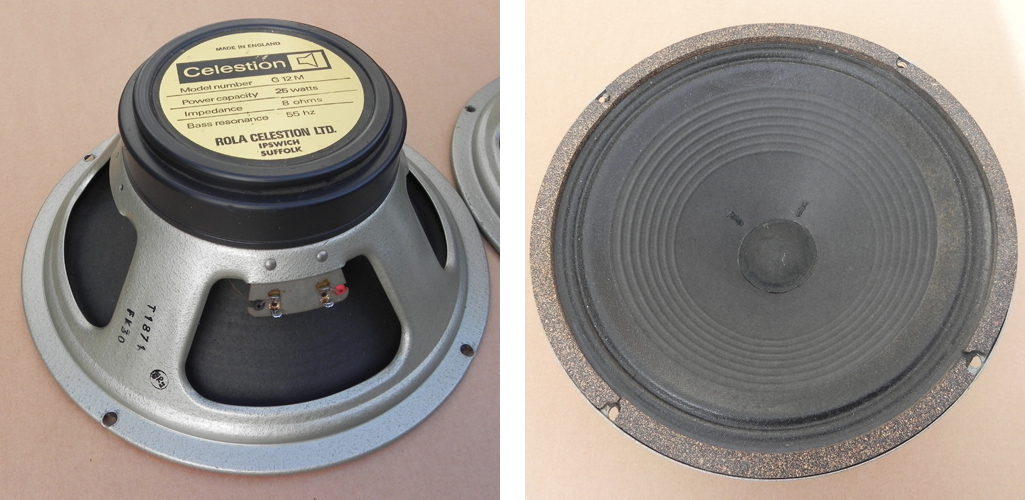
The T1871 is an 8 Ohm G12M speaker with 55Hz cone, similar to a T1511, but has the softer four ridge spider. Resulting in a more ‘open’ tone and a little more volume. Very nice sounding speakers.

Apparently made as early as 1971, but definitely much more common during blackback era (late 70’s). Probably a speaker designed for Vox, as they seem to turn up in late 70’s AC30’s quite a lot.
The Celestion log book entry suggests they were aiming for the Jensen sound: “SA3422 coil, SP444 cone, SP651 susp, res 50 max to match Jensen 1 1/2″ coil”
T1440 (16 Ohm)
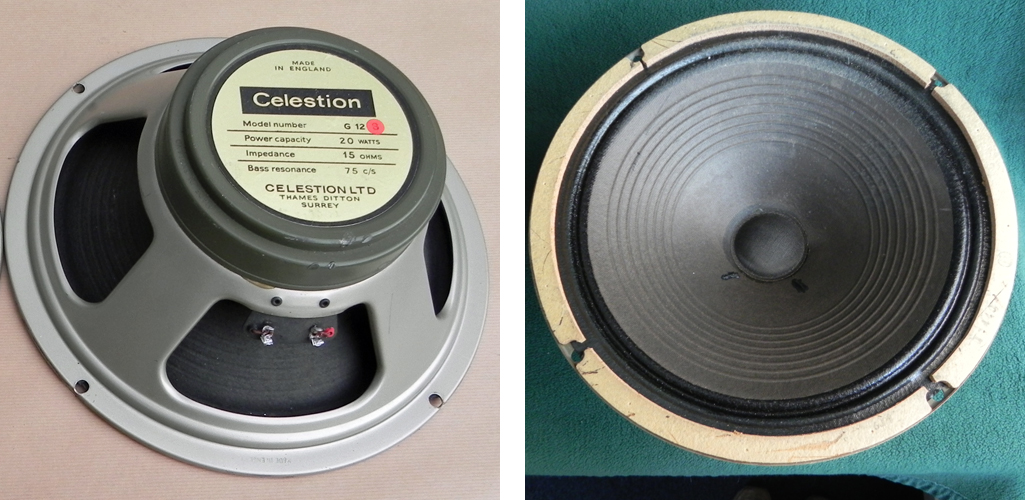
T1440 are probably my favourite Celestion greenback model, partly due to their rarity, but mainly because they just sound so awesome! These are a G12S model with 55Hz cone, and have just a thin band of doping at the cone edge.
They are punchy sounding speakers, with tight bass and clear highs, without the warmth and strong mids of the T1417. Try a pair of these with a 20w or 18w amp and crank that sucker!
‘Pre-rola’ period speakers usually come with a G12M magnet cover and the label ammended with a little red ‘S’ sticker. Another example of Celestion being short of labels during the 60’s.

A similar model is the T1449 which is basically the same speaker as far as I can tell. The Celestion log book entry for T1449 mentions a change in the doping, but having owned both models I could not see or hear a difference between them.
T2115 (8 Ohm)
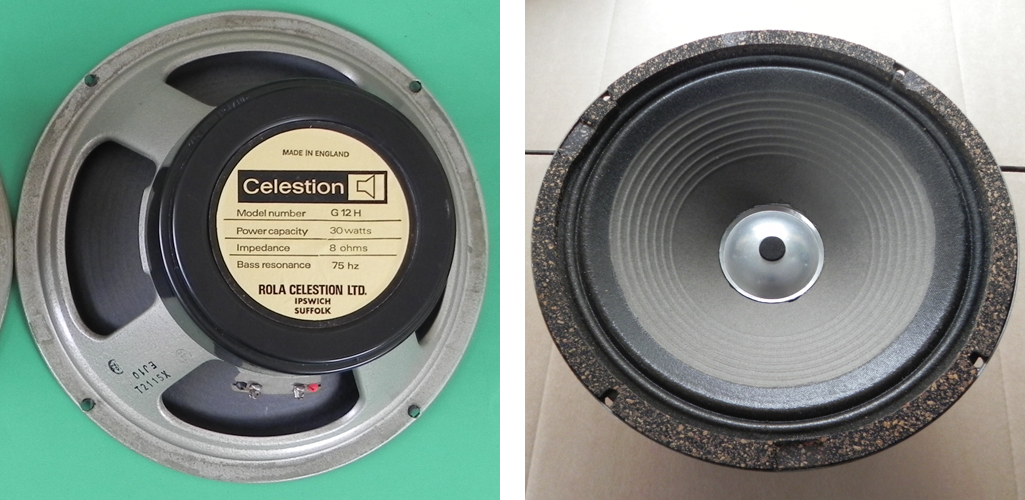
An 8 ohm G12H model with silver dust cap and 75Hz cone. Often found in front loading ‘Maine’ cabinets and combos. Most commonly found as blackbacks from the late 70’s, and as such the cone is typically the ‘1777’ stamped Kurt Mueller.
T2114 is a similar speaker with an M sized magnet.

Thank You Sir! Fine articles and very valuable information that could have been lost forever.
Author
Hi, many thanks, glad you are finding the info useful.
regards, Brian.
Hi Brian,
I have a pair of the T-2168’s.
Thank you so much for that info on them.
I’ll echo Spiders’ comment that you have compiled and saved facts that would have been lost forever.
Another speaker that I love are the Celestion/Vox alnico Silver Dogs.
https://www.voxshowroom.com/uk/amp/silverdg.html
Author
Hi Dave, and thanks, glad people are finding this information useful. I think the T2168’s are pretty rare, I haven’t seen many of those. The silver alnicos are great speakers too indeed. More info on those here:
https://www.voxac100.org.uk/celestion_silvers.htm
https://www.bygonetones.com/vintage-celestion-alnico-g12-models.html
regards, Brian.
Hi, I have a t1221 from the mid 70s its marked 8 ohms but tests at 13 ohms so is this a common misprint?
Author
Hi, yes sometimes they put the wrong labels on. Previous owners could have swapped the backs around too. T1221 is a 16 Ohm /15 Ohm speaker. 8 Ohm would be a T1220.
Brian.
Thanks for confirming that Brian, great site
Hi Brian, thank you so much for this great site! I’m sure your well versed in sensitivity of all these old speakers. I got two T1511 (1976 Blackback, Mueller Cone) and two T1534 (January 1973 Greenback, Pulsonic Cone) Mixed ’em in a 4×12 and they all seem to have the same sound level. That’s great for my 4×12 mix but shoudn’t the G12H be much louder than the G12M? I’ve just compared the G12H (pulsonic) to my new G12H Heritage (55c/s) which should be the “same” speakers but those are much louder than the pulsonics. Maybe something is wrong with the old ones? Thank you in advance and greetings from Germany
Stefan
Author
Hi Stefan, sorry for late reply. Not sure the G12H should be massively louder, but you should be able to hear a difference yes. It sounds as though those older G12H might have lost some strength in the magnets. I have heard this can happen, but am definitely not an expert on things like that. Hopefully someone else will read this and maybe offer another opinion.
Brian.
Brian, is the place of manufacture any form of dating the speaker, for instance, Thames ditton surrey compared to ipswich on the label, thanks , great site for info Tom
Author
Hi Tom, yes and no. The label can help date a speaker, but you need to be careful because the label transition dates can overlap massively. You need to look at the other features of the speaker as well such as the chassis style, date stamp style, cone stamp, colour of the magnet cover. All of those features combined should help date the speaker more accurately. This page should help:
https://www.bygonetones.com/how-to-date-vintage-celestion-greenbacks.html
Also be very careful with the whole pre-rola / rola thing, and Thames Ditton versus Ipswich. The truth is they were called Rola Celestion from 1947 onwards when British Rola and Celestion merged. Also they were making speakers from both the Ipswich factory and the Thames Ditton factory from late 1968 to 1975. The labels do not necessarily show this. More info here:
https://www.bygonetones.com/the-history-of-celestion.html
Hope that helps, Brian.
Brian, were there any reissue greenbacks made with solder terminals !
Author
Hi Tom, yes some of the heritage range came with solder terminals. Not sure if they still do though, or if it’s optional.
Brian.
Thanks, after I asked you the questions I read all of your info on them about the both factories making them until 1975, should have read the info on them first, really great site, thanks again!
Hi Brian, thank you for this treasure of knowledge. Do you like people to send pics? I have a quad of T1927 Red dot 10″ with 1973 date code MF13. Also a quad of T2348 date code LK1 which is 1977. Both quads came from higher end GBX powered cabs with Celestion logos on them. One cab is a bass cab and one is a guitar cab. They sound warm and rich, not flabby at all. Really sweet speakers for clean or overdriven tones.
Author
Hi Bruce, thanks for the info. Yes you can email me some pics no problem: info@bygonetones.com. Sounds like some nice speakers. I’m less familiar with the T2348, but I know the T1927 was used in the old Marshall PA cabs quite a lot in the 1970’s. I’ve had a few of those in the past. I agree, they are nice speakers and work very well with guitar, especially if they are the early ones with pulsonic cones.
Brian.
Saw a pretty uncommon type on ebay:
https://www.ebay.co.uk/itm/364039817731
No mention of this T number on your list, and I have never seen that extra cone on the dustcap.
If this is an original, maybe it is worth adding to the list.
Thanks for your great site, btw!
Author
Hi Thomas, thanks for the info. I will add it to the list.
Brian.
Hi Brian
I need some help and advice about an oddball speaker.
Recently I stumbled across a 1969 T1252 G12L Speaker, still with its original Pulsonic cone.
It seems in fair condition, although I couldn´t hear it, yet.
I am quite familiar with the ususal suspects, own a few G12H ans G12M Pulsonics, mainly 55Hz, but also at least on 75Hz (I usually prefer the 55Hz ones with the amps and playing style I use).
I am not sure what to expect and if to pull the trigger.
Surely, a G12L won´t barely have any bass. I read the treble being kinda dull. Usually 75Hz Greenbacks (namely the RIs) seem to be a bit harsh for MY playing (I don´t consider them harsh speakers per se) and the T1511 is about the most beloved type in my regard. The T1511 has subdued treble itsef. But will the T1252 be even mellower? I learned to like lighter, less bass heavy speaker recently and tend to like mellow speakers as well. But there´s a point when a speaker gets (by design) mushy and inarticulate. How is the G12L in that regard?
Thanks for helping me out before I lay down the money. The seller wants to see more of the upper side of the price range (in my opinion).
Best regards
Heiko
Author
Hi Heiko, sorry for the late reply. Yes if you are used to playing G12M and G12H speakers, then a G12L will definitely be missing a big chunk of bass in comparison for sure. To be honest it’s been a long time (several years) since I had a G12L speaker here, so my ears have long forgotten what the tone is like compared to other speakers, but I don’t remember the treble being dull last time I tried one, or the tone being mushy. I think some of that mushy sound you are referring to is often down to the ageing and condition of the cone itself rather than the speaker model, but I understand what you mean. Price wise I would be cautious about spending the big money on G12L model speakers unless you are a Vox collector and see a big collector value in them. The non Vox model G12L’s would be worth a fraction of the price of a similar period G12M or G12H in my opinion.
Hope that helps anyway,
Brian.
Hello Tom, excellent primer, thank you!
Two oddities I need clarification on:
1. My G12M T1511 with Pulsonic 102 015 cone is clearly a 55Hz model, judging from these numbers; but the original gold label on the back of the magnet says “G12M 75 c/s”. Did Rola ever mismatch labels on speakers? Is there a visual distinction between 75Hz and 55Hz cones?
2. Though the above speaker has a date stamp of July, 1970, it already says “Rola Celstion” on the label. When was the “Rola” name added to “Celestion” ?
Author
Hi Klaus, can you email me a photo of the speaker please? info@bygonetones.com Most likely the back cover is not original, or you are reading the date code incorrectly. I would need to see it to know what’s going on there. Although based on what you have written, I’m guessing it is probably from mid to late 71 (going by the Rola Celestion label with 75Hz on it). It is normal for the T1511 model to have 75Hz on the label until about 1972, even though the cone itself is the 55Hz version. They are all like that. The Rola Celestion text first appears around April 71.
regards, Brian.
I have recently been gifted an old 2 x 12 cabinet (unbranded) which has two T1220 greenbacks. Following your excellent articles on codes etc I can tell:
First one is a 1971 Pulsonic (102003). Sticker has Rola Celestion without the speaker icon which matches up to 1971 too. I did all your checks and the only issue is the spider support is partially loose.
The second is a 1972 Rola Celestion (with speaker icon) however it appears to have been re-coned as it looks very different, much bigger dust cover and has code 022003 (which I can’t find any info on). On checking, mostly okay except I get the scraping voice coil rub. Probably a crappy re-cone.
Regarding the first 1971, do you recommend I get the spider support glued professionally or is this something anyone can do?
Regarding the 1972, is it worth getting re-coned again vs just replacing the whole speaker?
Any help much appreciated and thanks for your great website!
Author
Hi, it sounds as though speaker 2 is near worthless, parts value only. So it is kind of upto you what you want to do with it. My opinion – re-coning can be expensive, but spare magnet covers are always handy to have 😉
As for the other one, it depends on how much of the spider support is lifting off. When only a small amount of the spider support is lifting off, you can usually just glue it back down. A bit of contact adhesive usually works, and weight it down with something whilst the glue sets.
However if a large area of the spider support is lifting off, say 40% or more, then it’s usually a bigger job. That’s because the glue at the edge of the spider support is the only thing holding the voice coil in it’s correct position. So when that glue has failed, the voice coil need to be re-positioned. If you glue back the spider with the voice coil seated at the wrong angle, it will rub. We are talking about fractions of a mm here. The coil gap is very thin and does not allow for much deviation from being in perfect parallel with the center of the magnet.
To do that you would need to remove the dust cap, re-shim the voice coil (I normally use a double layer of 35mm camera film as shims), then apply the glue. However, unfortunately what tends to happen is the glue is so corroded underneath the spider that fragments of it get into the coil gap whilst trying to repair it. This can be a problem, and some people resort to removing the whole cone to clean it out properly. Thesedays I try to avoid doing that whenever possible because it can alter the sound of the speaker.
This is why it is important to always check the spider support on a vintage Celestion before deciding their value when either buying or selling. Repairing speakers in poor condition is not always possible to do successfully, and that speaker you decided was a holy grail collector’s piece, can easily turn out to be worthless. That’s not aimed at you particularly, but anyone else that might be reading, just be aware that condition is everything with them when it comes to their value, and faults like this are very, very common.
I would recommend taking it to a pro speaker repair place if you are not confident doing the repairs yourself.
Hope that helps, Brian.
Thanks for replying Brian. I would say between 25 to 30% of the spider support is lifting in one continuous area. There is no coil rub currently so I will give it a go just regluing in the current position (as in where it is currently seated). Any particular contact adhesive you would recommend? Or one with particular qualities?
Regarding the second one I’ll probably just keep for spares then. I’m going to build a new cabinet (with plywood rather than the current MDF one). I also use a modelling amp (Axe-FX) so was thinking of putting an FRFR speaker in there to and then I can choose to go with direct to the actual Greenback or with an IR Cab through the FRFR (I don’t play loud enough to need both at the same time). Thanks again for your help, Geoff.
Author
Hi Geoff, 25 to 30 percent, I would probably just attempt to glue it straight back down, but depends on how cruddy the old glue is. Keeping crud out of the coil gap is the main issue. You might need to lightly sand the area first if it has gone really rusty.
I tend to use Evostick or Wayside Adhesives. The Wayside is a bit stronger and heat resistant, it is made for the motor industry.
Watch out for the other 70% popping off when you play through the speaker! Has happened to me before. Fix one side, then the other comes off!
Brian.
Fantastic. I’ll get that ordered. I might just put a small amount around the other 70% in the hope of strengthening it. Once I have re-affixed the loose part, is it worth risking manually lifting the rest with a razor blade or similar and gluing down but small amounts at a time, like 10% at a time? Rather than wait for the potential of the whole 70% coming off in one go with would require a lot of work to realign everything. Have you ever tried the same?
Author
Hi, yes I have done that in the past on speakers to future proof them. However, it really depends on the individual speaker and what state the old glue is in. Like I said, you really want to avoid getting any debris into the coil gap. So if that old glue is super rusted and corroded I would probably just leave it alone as much as possible. Maybe add a bead of glue over the top to hold it in place, or someone once suggested to me just putting some acetone over the top to re-soften the glue. If the spider glue is that rubbery pale yellow stuff (early to late 70’s?) that stays completely intact and flexible and you can access the underside cleanly, then it is probably worth doing. Late 60’s pre-rolas tend to go very crusty instead, different glue.
Brian.
The information here is incredible! Thank you!
Author
Hi Joey, thanks, and glad you are finding the information useful.
Brian.
Great Article !
I have a black-weave, straight Marshall 412 cab, supposedly from 1976, with “un-labeled” (plastic) Greenbacks (no Marshall sticker).
– but on the chassis leg is vertically stamped :
T1281
029 JB
– and an inspection stamp.
And 15Ω stamped on another leg.
Is this one of the fakes, since the date should come AFTER the letters ?
It’s a bit confusing, if they also reversed the month/year…
According to your Celestion Date Codes Chart, the “J” matches 1976, but then it should be stamped AFTER the “B”, right ?
– “B” matches 1969, but it doesn’t make sense for Marshall, to put speakers from 1969, into a cab made in 1976, right ?
Thanx
🙂
Author
Hi, those speakers will be from 69. Either the cab is also from 69 (possibly just painted black) or they are not original to it. If you email me some photos I should be able to date & authenticate everything for you. info@bygonetones.com
Brian.
Hi there. Fantastic website 👌👌👌
I just picked up an old tall Carlsboro 4 x12 cabinet. Speakers have no labels but I see the following codes on them – T2687 BK23
So looks like Feb 77 speakers.
Anyone know much about these. Are they much different from the T1221 everyone seems to look for?
Many thanks.
Paul
Author
Hi Paul, have you got any photos? info@bygonetones.com These apparently have the ‘power bulge’ magnet. Not many speakers have those. It’s a different magnet to the T1221, more rounded at the back. I’m not sure exactly what the purpose of it is, but suspect it allows for a higher power rating, or a larger voice coil. I would email drdecibel@celestion.com and see what info you can get from them about it. They have every speaker model on file there. Hope that helps, Brian.
Hi Brian.
Many thanks for the reply and for the celestion email address. Much appreciated.
I am away from home at the moment. Will take some photos and send later.
Cheers
Paul
Hi Brian,
I’ve recently gotten a hold of a Mk1 Selmer Treble n Bass 50w head. Great sounding amp but it’s just for lower volume home use and I’m tentatively running it through a 1×12 loaded with my favourite speaker: a 20w T1416 G12S (RIC cone), which I’d previously been safely using with an 18w head.
I have the amp pretty heavily attenuated (around -12db), never have the volume turned up into clipping territory and from the limited testing it’s getting a great sound, but it’d be a real shame to risk damaging such a wonderful old speaker – I’m wondering if you have any insight into whether this is safe enough (assuming I don’t do anything stupid like crank the volume and/or remove the attenuation) or whether you’d recommend swapping out the speaker to something higher rated? I know the sensible thing to do is just get a 50w+ speaker in the cab, but I just love the sound of a single G12S!
I’m not sure if it’s even possible to give a definitive answer to this, but I couldn’t think of anyone better to ask!
Many thanks, and I have to say this website has been an invaluable resource
-Jack
Author
Hi Jack, glad to hear you have been finding the website useful. Yeah the G12S are cool speakers. I think you’re probably safe with that attenuator. I would maybe consider upgrading to a 2×12 with another one of those RIC cone G12S. They can still be had fairly cheaply if you keep an eye on Ebay. A pair just sold very recently with the RIC cones. Brian.
Brian,
Thanks for the reply, I appreciate it!
I’ll definitely get myself a matching speaker to pair with it when I get around to getting a 2×12 cab.
I managed to get a NOS G12-50 from the 80s very cheap with a 2802 cone – I had to cut the whizzer off and refit the dustcap, but it’s getting a surprisingly great sound at really low volumes. I’ll probably hang onto that one to use for the 1×12.
Good to know I won’t have done any damage to the G12S in the meantime!
-Jack
Hi. I have a G12H I think. with a 3 ridge green spider.. code on chassis leg looks like 1229.. but there are a couple of black marks after that, that aren’t legible. Possibly a ‘3’ on the cone in black ink stamp. Chassis is hammered silver paint. 8 ohm green sticker. has 2 flat sections to the side of the magnet. Cheers.
Author
Hi Gem, can you email me some photos? I will try to identify it for you. info@bygonetones.com
thanks, Brian.